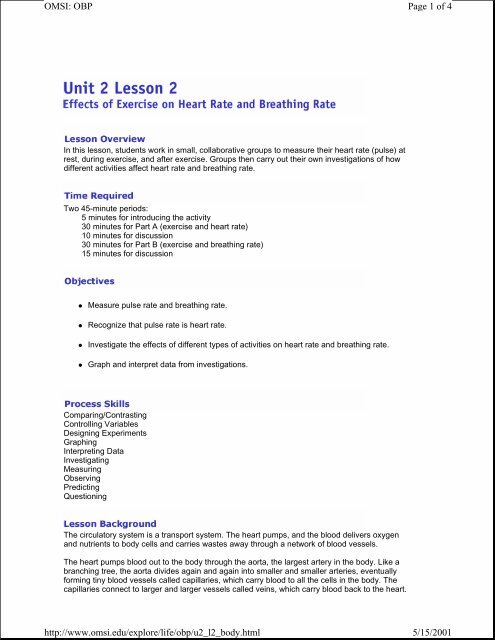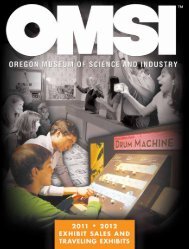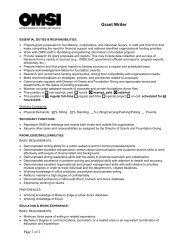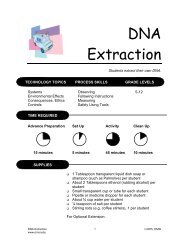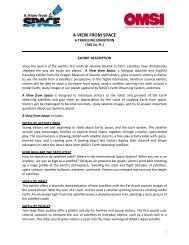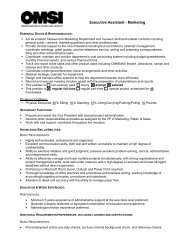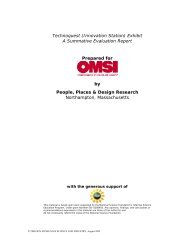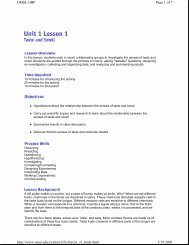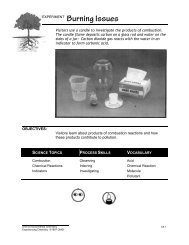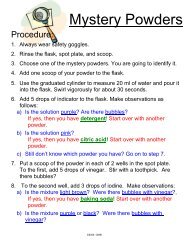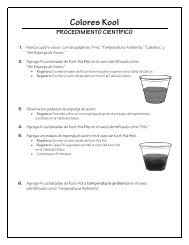Lesson 2: Effects of Exercise on Heart Rate and Breathing Rate - OMSI
Lesson 2: Effects of Exercise on Heart Rate and Breathing Rate - OMSI
Lesson 2: Effects of Exercise on Heart Rate and Breathing Rate - OMSI
You also want an ePaper? Increase the reach of your titles
YUMPU automatically turns print PDFs into web optimized ePapers that Google loves.
<strong>OMSI</strong>: OBPPage 3 <str<strong>on</strong>g>of</str<strong>on</strong>g> 4Ask students how fast they think their heart beats when they are sitting still. To dem<strong>on</strong>strate howhard the heart works every minute, have student volunteers try the following activity:! Set two wash basins next to each other <strong>on</strong> a table. (Be sure to protect the surface fromspills.) Fill <strong>on</strong>e wash basin two-thirds <str<strong>on</strong>g>of</str<strong>on</strong>g> the way with water.! Have <strong>on</strong>e student use a stopwatch or clock with a sec<strong>on</strong>d h<strong>and</strong> to time <strong>on</strong>e minute.! Give the other student a plastic cup that holds about 150 mL (about the amount <str<strong>on</strong>g>of</str<strong>on</strong>g> bloodan adult heart pumps with each beat).! Challenge the student to use the cup to try to move the water from <strong>on</strong>e basin to the otheras fast as the heart pumps. To pump as fast as an average adult heart, the student wouldhave to move 70 cupfuls in <strong>on</strong>e minute.ProcedurePart A1 Dem<strong>on</strong>strate for students how to take a pulse at the wrist (radial artery) <strong>and</strong>at the neck (carotid artery). To find a pulse rate: Place the index <strong>and</strong> middlefingers <strong>on</strong> your wrist or your neck. (D<strong>on</strong>'t use your thumb. It has it's ownstr<strong>on</strong>g pulse.) Hold your fingers there until you feel the steady beat <str<strong>on</strong>g>of</str<strong>on</strong>g> yourpulse. (You may have to move your fingers around a little until you find thestr<strong>on</strong>gest pulse. D<strong>on</strong>'t press too hard.)2 Help students find their own pulses at these two places. Ask students whatthe pulse rate measures. Explain that with each heartbeat, the heart sends awave <str<strong>on</strong>g>of</str<strong>on</strong>g> blood surging through the blood vessels known as arteries. You canfeel this surge <str<strong>on</strong>g>of</str<strong>on</strong>g> blood most easily at places where arteries are near thesurface <str<strong>on</strong>g>of</str<strong>on</strong>g> the skin, such as at the inside <str<strong>on</strong>g>of</str<strong>on</strong>g> the wrist or the side <str<strong>on</strong>g>of</str<strong>on</strong>g> the neck.By measuring pulse rate we are actually measuring heart rate.3 Have all students measure their pulse rate while seated quietly at theirdesks. Explain that this is a resting pulse rate. Students can determine theirpulse rate by counting the pulses in 15 sec<strong>on</strong>ds <strong>and</strong> multiplying that numberby 4 (to get heartbeats per minute). Have students find their pulses, then givea signal <strong>and</strong> have students count the pulses, while you time 15 sec<strong>on</strong>ds.4 Ask students: What do you think happens to your heart rate when you run?Why? Record students' hypotheses <strong>on</strong> the board.5 Then have students jog in place for 1 minute. At the end <str<strong>on</strong>g>of</str<strong>on</strong>g> that time, havethem determine their heart rates as they did before.6 Have students compare their resting <strong>and</strong> active heart rates. Collect classdata in a chart <strong>on</strong> the board. Plot the data <strong>on</strong> a bar graph. Have studentslook for patterns in the data.7 Let students work in small groups to investigate the effect <str<strong>on</strong>g>of</str<strong>on</strong>g> an activity <strong>on</strong>heart rate. Students might choose an activity such as stair climbing, laphttp://www.omsi.edu/explore/life/obp/u2_l2_body.html5/15/2001
<strong>OMSI</strong>: OBPPage 4 <str<strong>on</strong>g>of</str<strong>on</strong>g> 4running, raising <strong>and</strong> lowering an arm, doing a headst<strong>and</strong>, or playing a boardgame. Each activity should be carried out for the same amount <str<strong>on</strong>g>of</str<strong>on</strong>g> time, sothat groups can compare data.8 Have the class discuss opti<strong>on</strong>s <strong>and</strong> agree <strong>on</strong> the amount <str<strong>on</strong>g>of</str<strong>on</strong>g> time <strong>and</strong> generalprocedures for collecting data. For example, students might decide to takethe participant's pulse before the activity, during the activity, at the end <str<strong>on</strong>g>of</str<strong>on</strong>g> theactivity, <strong>and</strong> 5 minutes later.9 Help students determine the specific procedures for their investigati<strong>on</strong>s. Youmay want to discuss how to c<strong>on</strong>trol variables <strong>and</strong> how to test just <strong>on</strong>evariable at a time. You may also want to give students a sample data table.10 Have students graph their data <strong>and</strong> share the results <str<strong>on</strong>g>of</str<strong>on</strong>g> their investigati<strong>on</strong>s.Have students look for patterns in the data reported. You might want tointroduce the terms aerobic <strong>and</strong> anaerobic <strong>and</strong> have students drawc<strong>on</strong>clusi<strong>on</strong>s about the effect <str<strong>on</strong>g>of</str<strong>on</strong>g> each type <str<strong>on</strong>g>of</str<strong>on</strong>g> activity <strong>on</strong> heart rate <strong>and</strong> theimportance <str<strong>on</strong>g>of</str<strong>on</strong>g> aerobic activity in strengthening the heart.Part B1 Ask students: How do you think exercise affects your breathing rate? Why?2 Help students design investigati<strong>on</strong>s into the effects <str<strong>on</strong>g>of</str<strong>on</strong>g> different types <str<strong>on</strong>g>of</str<strong>on</strong>g>activities <strong>on</strong> breathing rate.3 Let students share the results <str<strong>on</strong>g>of</str<strong>on</strong>g> their investigati<strong>on</strong>s <strong>and</strong> look for c<strong>on</strong>necti<strong>on</strong>swith the data they collected earlier <strong>on</strong> exercise <strong>and</strong> heart rate.! Have students find out the average heart rates for different animals <strong>and</strong> graph them <strong>on</strong> abar graph to compare with students' average heart rates.! Have students design an investigati<strong>on</strong> <strong>and</strong> collect data <strong>on</strong> how l<strong>on</strong>g it takes their heart rateto return to its normal, resting rate after exercise. (In general, the fitter you are, the fasteryour heart rate returns to normal because a fitter heart is more efficient at pumping blood.)! Have students calculate how many times their heart beats (or their lungs inhale <strong>and</strong>exhale) in <strong>on</strong>e hour, <strong>on</strong>e day, <strong>and</strong> <strong>on</strong>e year.Have students summarize the results <str<strong>on</strong>g>of</str<strong>on</strong>g> class investigati<strong>on</strong>s in a news article.Home | About OBP | Inquiry | Print | FeedbackUnit 2 Overview | <str<strong>on</strong>g>Less<strong>on</strong></str<strong>on</strong>g> 1 | <str<strong>on</strong>g>Less<strong>on</strong></str<strong>on</strong>g> 2 | <str<strong>on</strong>g>Less<strong>on</strong></str<strong>on</strong>g> 3 | <str<strong>on</strong>g>Less<strong>on</strong></str<strong>on</strong>g> 4 | <str<strong>on</strong>g>Less<strong>on</strong></str<strong>on</strong>g> 5 | <str<strong>on</strong>g>Less<strong>on</strong></str<strong>on</strong>g>6Oreg<strong>on</strong> Museum <str<strong>on</strong>g>of</str<strong>on</strong>g> Science <strong>and</strong> Industry | http://www.omsi.edu/explore/life/obp/http://www.omsi.edu/explore/life/obp/u2_l2_body.html5/15/2001


